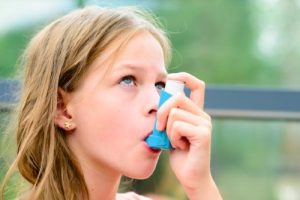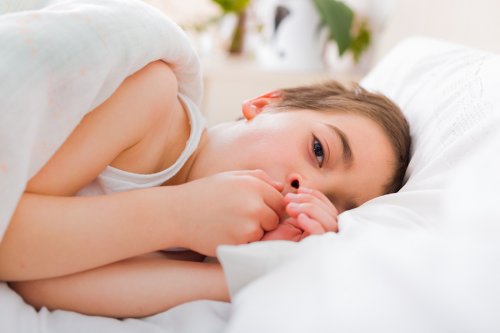Respiratory Infections in Children: What to Know

Respiratory infections in children consist of pathogens invading the body, causing illnesses in the respiratory tract.
This tract is made up of the nostrils, the mouth, the pharynx, and the larynx at the upper level, and the trachea, the lungs (bronchial tubes, bronchioles), and the pulmonary alveoli at the lower level.
Some children have immunological irregularities that make them more susceptible to these types of respiratory infections. Similarly, there are circumstances that can contribute to an infection, either due to the environment, or because of family attitudes.
What are the risk factors?
There are various conditions that promote the development of respiratory infections in children. These can go hand in hand with parental care and interaction with other family members, and include:
- Inadequate breastfeeding: in other words, when the baby isn’t exclusively breastfed, or was only breastfed for a few months.
- Malnutrition: improper diets can weaken children’s defenses and thin the pulmonary membrane, allowing microorganisms to enter.
- Cigarette smoke: close relatives exposing a child to cigarette smoke can affect his or her breathing capacity.
- Housing conditions and overcrowding: when the child sleeps in a room with more than three people, his or her hygiene and safety is put at risk.
Symptoms of respiratory infections in children
To get more specific with the symptoms, you need to take into account that the respiratory system is divided into two parts: the upper tract (nose, mouth, and throat) and the lower tract (bronchial tubes and lungs).
The symptoms that usually accompany a respiratory infection include:
- Cough.
- Headache.
- Fever.
- Irritability.
- Snoring.
- Ear pain or secretions.
- Congested nose due to mucus secretion.

Symptoms of upper respiratory system infections
- The common cold: this is highly contagious and affects the majority of children. Symptoms include nasal congestion, sneezing, sore throat, dry cough, and a slight fever.
- The flu: this is similar to a cold, but with more complications. The child will experience a fever with chills, fatigue, weakness, possible stomachache, and vomiting.
- Croup: this illness inflames the trachea, the larynx, and the bronchioles. You can identify it by a hoarse or low-pitched cough and also by noisy breathing.
- Sinusitis: a viral infection that causes inflammation and the accumulation of excess mucus, which causes a deposit of germs in the child’s sinuses.
Symptoms of lower respiratory system infections
- Respiratory syncytial virus (RSV): this affects the majority of children under two years of age. Its symptoms are similar to those of the common cold. It causes breathing difficulties and, in severe cases, asthma.
- Bronchiolitis: this affects children under two, especially between three and six months. It inflames the passages that carry air to the lungs, making breathing difficult.
- Pneumonia: this infection attacks children’s lungs, producing fluids that accumulate in the respiratory tract and hinder breathing.
- Asthma: this causes inflammation of the child’s airways, an increased heart rate, shortness of breath, and lack of air when running and playing.
- Gastroesophageal reflux disease (GERD): when the muscle that closes the opening between the child’s stomach and esophagus isn’t working properly, bits of food and gastric acid pass from the stomach into the esophagus, causing irritation and a burning sensation.
- Respiratory allergies: these are the result of the allergens in the child’s environment, and cause nasal congestion, watery eyes, a tight throat, and sneezing, among other symptoms.
- Anaphylaxis: this is an allergic reaction to insect bites, latex, medicines, or food.
Preventing infections in children
Some public health organizations, such as the Argentinean Ministry of Health, have highlighted measures that can be taken to prevent your children and infants from catching respiratory infections:
- Maintain proper hygiene when handling newborns.
- If your baby is underweight, bring the child in for a medical checkup as soon as possible.
- In the case of infants, continue with breastfeeding to strengthen the immune system until at least six months.

- Air out the room, and avoid sudden changes in temperature. Also: avoid enclosed spaces.
- Keep your home smoke-free and prevent people who smoke from doing so nearby.
- Strengthen the body’s defenses with a proper diet.
- Tell your children to wash their hands on both sides when they get home and before every meal.
- Avoid letting children share their things, such as toys, utensils (plates, glasses, cutlery), and food.
- Make sure to dress them warmly when it’s cold out.
- If you have any symptoms like cough, fever, or nasal congestion, or if you experience rapid breathing, wheezing, or snoring, then head to the doctor immediately.
“Although your children may lose their appetite due to the respiratory infection, it’s essential that you feed them well.”
Respiratory infections in children may be unavoidable, but at the very least we can reduce the risk. This type of illness can be treated with medication. However, if you don’t head to the pediatrician in time, they can lead to severe complications.
All cited sources were thoroughly reviewed by our team to ensure their quality, reliability, currency, and validity. The bibliography of this article was considered reliable and of academic or scientific accuracy.
- Álvarez Castelló, M., Castro Almarales, R., Abdo Rodríguez, A., Orta Hernández, S. D., Gómez Martínez, M., & Álvarez Castelló, M. D. P. (2008). Infecciones respiratorias altas recurrentes: Algunas consideraciones. Revista cubana de medicina general integral, 24(1), 0-0. http://scielo.sld.cu/scielo.php?script=sci_arttext&pid=S0864-21252008000100011
- Benguigui, Y., Antuñano, F. J. L., Schmunis, G., & Yunes, J. Y. (1997). Infecciones respiratorias en niños. OPS.
- Cohen R, Just J, Koskas M. (2005). Infecciones respiratorias recidivantes en pediatría, cómo estudiarlas y tratarlas. Archivo de Pediatría. 2005;12(2):183-90.
- Lozano, J., Yánez, L., Lapadula, M., Lafourcade, M., Burgos, F., Budnik, I., & Herrada, L. (2008). Infecciones respiratorias agudas bajas en niños: Estudio etiológico prospectivo. Revista chilena de enfermedades respiratorias, 24(2), 107-112. https://scielo.conicyt.cl/scielo.php?pid=S0717-73482008000200004&script=sci_arttext
- Pérez Sánchez, M., Fundora Hernández, H., Notario Rodríguez, M., Rabaza Pérez, J., Hernández Sánchez, M. D. L. Á., & Rodríguez Bertheau, A. (2011). Factores de riesgo inmunoepidemiológicos en niños con infecciones respiratorias recurrentes. Revista cubana de pediatría, 83(3), 225-235. http://scielo.sld.cu/scielo.php?script=sci_arttext&pid=s0034-75312011000300002
This text is provided for informational purposes only and does not replace consultation with a professional. If in doubt, consult your specialist.








